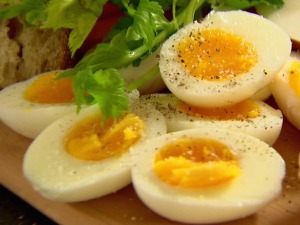Eggs have always been a key component of American’s diet. In fact, until we became primarily an urban society, always rushing to get to our jobs and classrooms, eggs were on the breakfast table each day for almost every man, woman, and child. Eggs provided the energy for a hard working day. While lifestyles have changed, eggs remain one of the single most nutritional and enjoyable foods today. In fact, each American consumes approximately 250 eggs per year. Approximately 70% of egg consumption is in the form of shell eggs and 30% in egg products. You probably are not aware of all the ways in which you consume eggs. Within the egg products sector of our business, many eggs are used as an ingredient in the manufacturing of other food items such as cakes, pasta, etc.
Eggs are a low-cost source of high-quality protein. Protein in the diet supplies nitrogen and amino acids that are needed to synthesize proteins in the human body. Eggs are used as the reference standard for measuring protein quality. As a recent article in the professional journal Nutrition Today put it: “There is no higher quality protein than that provided in eggs.”
Eggs also promote satiety – feeling full, not hungry. Studies have shown that when on a weight control diet eating an egg helps avoid the mid-morning hunger than can lead to excess snacking. Thus, eating eggs may help promote weight loss while providing a wide array of healthy nutrients.
Egg yolks are an excellent source of choline, an essential nutrient that contributes to fetal brain development and helps prevent birth defects. Scientists are increasingly aware of the importance of choline, especially for pregnant women, and eggs are among the relatively few excellent sources. Choline also aids in brain function of adults by maintaining the structure of brain cell membranes, and is a key component of the neuro-transmitter than helps relay messages from the brain through nerves to the muscles.
Eggs provide small amounts of lutein and zeaxanthin, two nutrients which are part of the carotenoid family and contribute to eye health and help prevent and even slow the progression of common causes of age-related blindness, such as macular degeneration.
Speaking of the nutritional value of eggs, did you know besides providing energy from protein and fat, one large egg also contains levels of several B vitamins, including thiamin, riboflavin, folate, B12 and B6, needed for the body to produce energy? Because the protein in eggs is rich in the amino acid leucine, it plays a role in regulating blood sugar and helping muscles use energy efficiently. Eggs provide energy without causing a sudden rise in blood sugar or insulin levels, which can ultimately cause premature fatigue.
Some farm families long ago knew about the importance of eggs in providing them the energy for a hard-working day. While most of us may not be farm workers today, it does not change the fact that we all need as much energy as possible to get through our busy days.
(Courtesy of http://www.rosemaryfarm.com)




